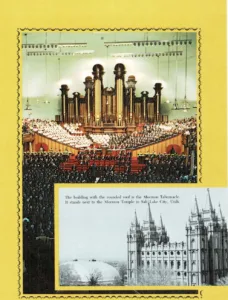NO ECHOES
If you talk or sing before an audience, and your voice echoes, the echo
makes your words bump into each other. That’s bad, because people can’t
understand what you’re saying or singing.
Great musicians of the world like to sing and play in places that don’t
have echoes. When a violinist plucks once on his violin string, he wants
to hear “plunk, not “plunk, plunk.
People who design auditoriums and opera houses study a science called
acoustics (uh [koos]{.smallcaps} tihks). The study of acoustics helps
them know about sound and how to control it.
One place known for its good acoustics is a church called the Mormon
Tabernacle in Salt Lake City, Utah.
The tabernacle’s roof looks like an upside-down bowl. Large timbers were
cut or bent to make the roof curve. The builders fastened the timbers
together with large wooden pins.
If you drop a needle on the floor at one end of the Mormon Tabernacle,
people can hear the “plink” at the opposite end. That’s good acoustics!
Maybe that\’s why so many people enjoy hearing the famous organ and
choir in the Mormon Tabernacle.


